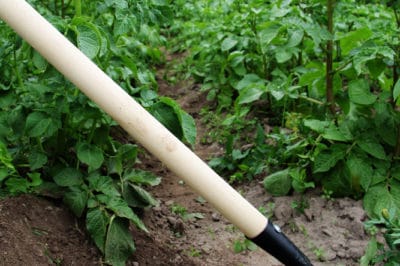Basic Steps in Growing Potatoes
Potatoes can be grown in all USDA Zones. Here are the basics:
- Always plant in full sun.
- Grow in fertile, well-drained soil that is a little acidic.
- Supply nutrients with organic 10-10-10 fertilizer or well-rotted compost, greensand, wood ashes and kelp.
- Water at least weekly during the growing season but don’t let the soil get soggy.
- Harvest new potatoes three weeks after flowering, the main crop when tops die down.
Reasons to Hill Potatoes
Potatoes develop their tubers along the underground part of the stem. These tubers are often just below the surface and if exposed to direct sunlight, may become green and inedible. Exposed potatoes may also become sunburned, especially in warmer areas. Hilling protects the tubers. Hilling also helps keep the plant’s roots cool and keeps moisture in the soil.
Hilling in Trenches
Potatoes grow best in loose, friable soil with plenty of organic matter. This kind of soil is also the best for hilling. Many people plant their potatoes in trenches, about six to eight inches deep. Once the plants are about six inches high, the gardener applies soil to cover three-quarters of the plant. New roots and tubers will develop along the buried stem.
How to Hill
Hilling is just a matter of using a rake or hoe to pull soil up along the sides of the potato plant. If your soil is hard or crusted, you may need to till or work the soil prior to hilling so the soil will be loose enough. Simply rake or hoe the soil around the plants. Be careful not to damage leaves or to hoe deeply enough to harm the roots or developing tubers.
When to Hill
Most gardeners hill their potatoes twice. The first hilling takes place when the plants are about six to eight inches tall. The second hilling occurs a few weeks later. In both cases, about three-quarters of the exposed plant should be covered. Two hillings is sufficient for early and mid-season potato varieties. For long-season varieties, you might want to hill a third time.
Mulching Instead of Hilling
The whole purpose of hilling is to cover the developing tubers. You can achieve the same effect by mulching with compost, straw or leaves. This system works best if the potatoes are planted in a trench rather than individual holes or containers. Cover the plants at the same times as you would if hilling, but use mulch instead of soil. Water well after mulching.
